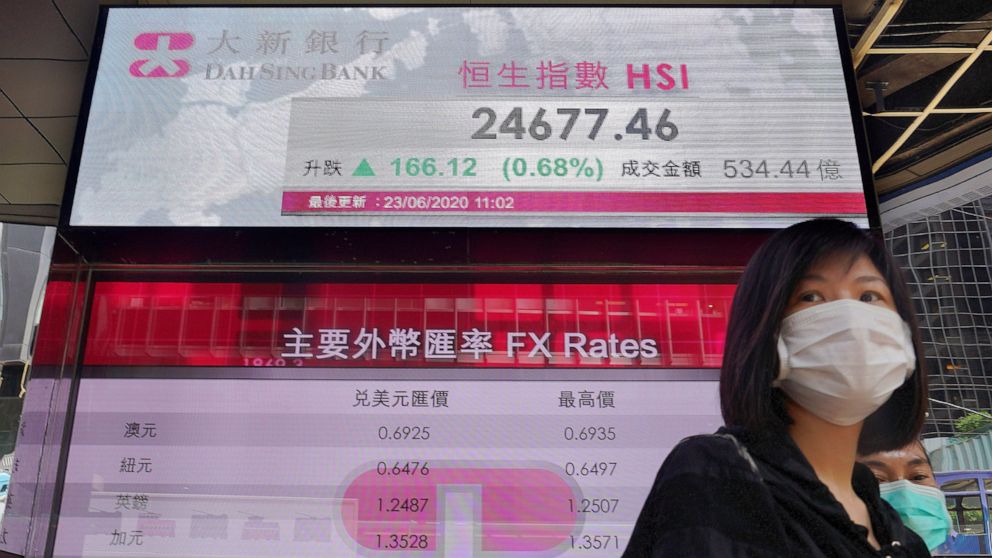Asia shares higher after US rally despite rising virus fears
TOKYO — Asian shares were mostly higher on Wednesday with another mood boost from Wall Street, but fears persist over the surge in coronavirus cases in parts of the world.
Japan’s benchmark Nikkei 225 edged 0.1% higher to 22,576.63. Australia’s S&P/ASX 200 also picked up 0.1% to 5,958.40. South Korea’s Kospi added 1.5% to 2,162.46. Hong Kong’s Hang Seng slipped 0.1% to 24,854.72, while the Shanghai Composite added 0.2% to 2,976.39.
Analysts are warning that, despite the recent market rallies, there is little reassurance infections won’t keep spreading, given the growing numbers in some parts of the U.S., Brazil and Asia.
“The nuance though is that the recovery falls short of being entrenched,” said Hayaki Narita of Mizuho Bank, adding trade contractions for various countries this year are expected to be the worst ever.
Prakash Sapal, senior economist for ING, said the focus is slowly shifting back to the COVID-19 pandemic from optimism about a rebound from loosening lockdown restrictions.
“The recent acceleration in infections has rekindled concern that governments will be forced to shut down their economies once again, squandering the chance for the much-hoped-for economic bounce back,” he said in a report.
On Wall Street, the S&P 500 rose 0.4% and is on pace for its third straight monthly gain. The Nasdaq composite, which is heavily weighted with technology stocks, climbed to an all-time high for the second day in a row. Bond yields rose, another sign of increasing confidence in the economy.
Health care stocks and companies that rely on consumer spending were also among the big gainers, while safe-play sectors like real estate and utilities stocks fell.
Investors have been focused on the prospects for an economic recovery as more businesses reopen after being shut down due to the coronavirus pandemic. Encouraging economic data, including retail sales and hiring, have helped stoke optimism that the recession will be relatively short-lived.
Wall Street has grown confident that the Federal Reserve and Congress are prepared to continue providing a historic amount of support to the market and economy, said Sam Stovall, chief investment strategist at CFRA.
“All of the negative news has basically been built into share prices,” Stovall said. “If we are to stumble, then the Fed and Congress are likely to step in to put a fiscal and monetary floor underneath the economy and the markets. And now, with the likelihood that the economy will not be shutting down entirely should we end up with a second wave, the market is basically saying it’s ‘onward and upward.’”
The S&P 500 rose 13.43 points to 3,131.29. The Dow Jones Industrial Average gained 131.14 points, or 0.5%, to 26,156.10. The Nasdaq climbed 74.89 points, or 0.7%, to 10,131.37. The index has only fallen twice so far in June. The Russell 2000 index of small company stocks picked up 5.81 points, or 0.4%, to 1,439.34.
The market has continued to climb, despite bouts of volatility, even as a rise in new coronvairus cases in the U.S. and other countries clouds the prospects for an economic recovery.
The World Health Organization said over the weekend that the pandemic is still in its ascendancy. The U.S., which is seeing rapid increases in cases across the South and West, has the most infections and deaths by far in the world, with 2.3 million cases and over 120,000 confirmed virus-related deaths, according to a tally by Johns Hopkins University.
Its global reckoning puts the total number of cases worldwide at more than 9.2 million, with more than 476,000 deaths.
On Tuesday, Federal health officials told Congress to brace for a second wave of coronavirus infections in the fall and winter of this year.
While the virus remains a concern as businesses reopen, new cases aren’t yet that concerning, said Jason Draho, head of Americas asset allocation at UBS Global Wealth Management.
“Right now, that’s something to monitor, but when you look at the underlying data, it’s all still at levels that are not too concerning as opposed to where we were back in March and April,” he said.
Investors have been placing more weight on economic data releases that suggest economies that have reopened are making strides to emerge from a deep recession. Further updates on the U.S. economy are expected toward the end of this week, when the government will issue data on consumer spending, weekly unemployment aid applications and durable goods orders.
In energy trading, benchmark U.S. crude oil slipped 31 cents to $40.06 a barrel in electronic trading on the New York Mercantile Exchange. It fell 9 cents to $40.37 a barrel Tuesday. Brent crude, the international standard, lost 22 cents to $42.51.
The dollar rose to 106.54 Japanese yen from 106.53 yen on Tuesday. The euro cost $1.1316, up from $1.1307.
———
AP Business Writers Alex Veiga and Damian J. Troise contributed.
![]()


